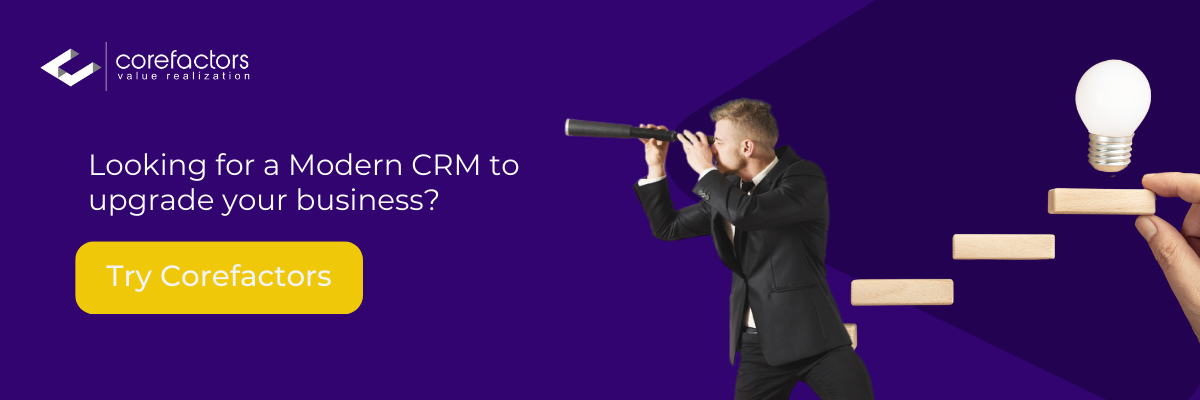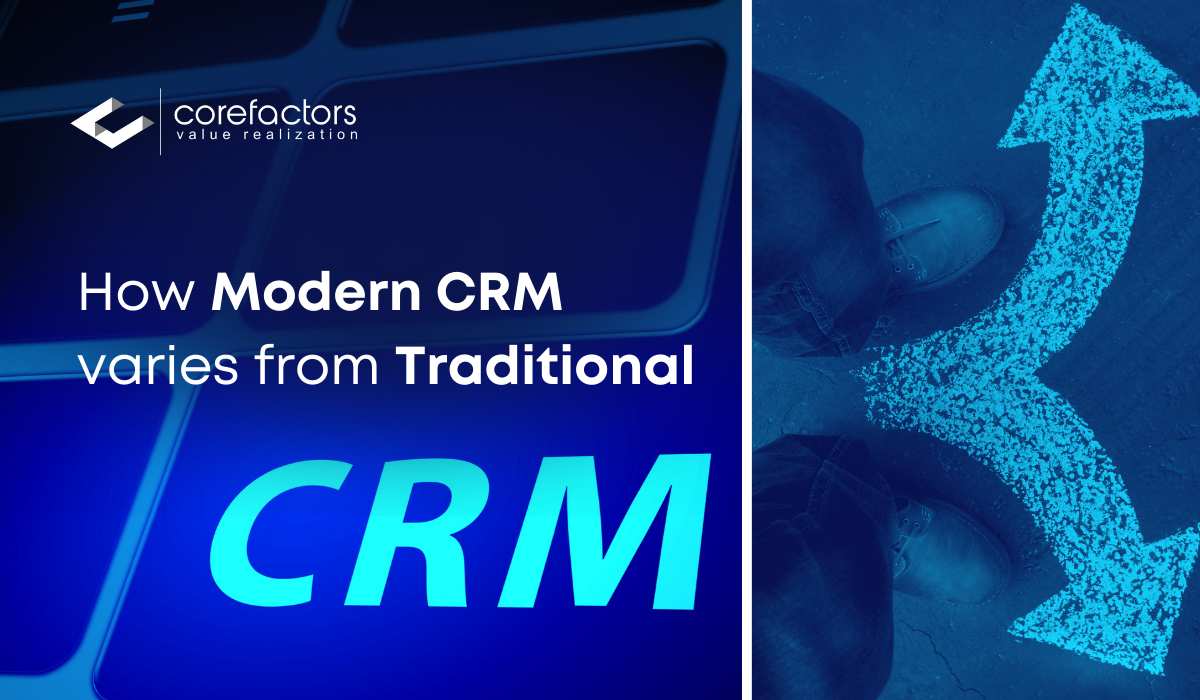Remember the manual ledgers? Those thick bound books filled with handwritten notes and transactions, flipping through pages to manually update details was the early version of the CRM system.
Fast forward to today, CRM systems have completely transformed how we handle customer relationships. The world and customer engagement have evolved dramatically. So, here’s the real question: Is your CRM evolving with the times, or is it stuck in the past?
Traditional CRMs, once limited to basic data storage, no longer suffice in today’s hyper-connected world. Modern CRMs now offer so much more from tracking behavior across channels to delivering personalized experiences.
In this blog, we'll explore how these once-simple tools have transformed into powerful systems for today’s needs.
Traditional Vs Modern CRM: A Basic Comparison
Customer Relationship Management (CRM) systems have evolved significantly over time. Here’s a quick comparison between traditional and modern CRM systems, highlighting their key differences:
The Evolution of CRM
Beyond these basic differentiations, the CRM has witnessed a remarkable transformation from a basic data storage system to a sophisticated data-driven platform. We are not speaking of the technological advancements but also the change in how businesses interact with and understand their customers.
1. From Data Storage to Data Insight: The Intelligence Factor
Traditional CRM systems were primarily about storing customer information: names, addresses, and transaction history, in centralized databases. While this approach ensured that data was accessible, analyzing the data was a manual grind, often missing the key trends and insights. It was like having a massive pile of documents but no way to quickly read between the lines.
Now, modern CRM systems store the data and also understand them. More like a system that logs purchases and predicts what your customers want before they buy.
Modern CRMs use advanced analytics and AI to turn raw data into actionable insights, anticipating customer needs, detecting patterns, forecasting trends, and personalizing interactions.
This switch is the backbone of customer-centricity today.
2. From Transactional to Experiential: The Customer Journey Focus
Traditional CRM was often built around a transactional mindset; tracking the sales, managing customer service, and occasionally using data for marketing. This was a largely linear approach: attract a customer, close the deal, and move on to the next. While functional, it missed the bigger picture, the ongoing relationship with the customer.
In contrast, modern CRM prioritizes customer experience (CX), mapping the entire journey and tracking touchpoints across channels like social media, email, and customer service. Customers are no longer just sales figures; they're advocates and repeat buyers. Modern systems personalize communication, automate nurturing, and optimize experiences, turning one-time buyers into loyal advocates by offering tailored follow-ups based on preferences and past behavior.
While old CRMs simply noted a purchase, modern CRMs understand customer preferences and send tailored follow-up offers based on browsing history and past purchases. This encourages one-time buyers to make repeat purchases, enhancing their overall experience with your brand.
3. From Static to Dynamic: Real-Time Engagement
Traditional CRM systems were slow, updating customer data only periodically, often when new info was manually entered or after interactions. This created delays, with outdated data impacting response times.
Modern CRM systems have transformed this by offering real-time updates. Now, as soon as a customer inquires, engages on social media, or clicks an email link, the system captures and updates this information instantly. This real-time capability allows businesses to react swiftly and accurately.
For example, while an old CRM might miss a cart abandonment until reviewed manually, a modern CRM detects it immediately and can automatically send a follow-up email or discount offer. This real-time engagement boosts responsiveness, improves customer experience, and drives higher conversion rates.
4. From One-Size-Fits-All to Hyper-Personalization
Traditional CRM systems were rigid and one-size-fits-all, treating every customer the same regardless of their unique needs. Customization was limited, and the focus was more on the business's needs rather than tailoring experiences to individual customers. This often led to generic interactions that didn’t resonate with anyone specifically.
Modern CRM systems have flipped this script with hyper-personalization. Using AI, big data, and behavioral analytics, they tailor every interaction based on detailed insights, like purchase history, browsing habits, and even predicted future behavior.
For instance, while a traditional CRM might send a uniform promotional email to all customers, a modern CRM can dynamically adjust the content based on individual data points. If a customer frequently buys tech gadgets, the system can send a personalized offer for the latest gadget accessory, timed perfectly after their last purchase.
5. From Sales-Centric to Multi-Functional: A Unified Approach
Traditional CRM was mostly sales-centric, tracking leads and closing deals but leaving out other departments like marketing and customer service. This resulted in scattered data and fragmented customer experiences.
But modern CRM systems unified all departments. They provide an all-in-one solution where sales, marketing, customer support, and operations can all collaborate seamlessly. Everyone accesses the same data, ensuring consistent, meaningful interactions across all touchpoints. This connected ecosystem improves collaboration, breaks down silos, and enhances customer experience.
As per Forbes, companies that effectively organize and manage customer experience can realize a 20% improvement in customer satisfaction, a 15% increase in sales conversion, a 30% lower cost-to-serve, and a 30% increase in employee engagement.
For example, support teams in modern CRMs can access a customer’s full history, providing contextually relevant help and allowing marketing to tailor future campaigns, ensuring a seamless customer experience.
6. From Manual Input to Automated Intelligence
One of the most challenging aspects of traditional CRM systems was the reliance on manual data entry. Sales and support teams had to input notes, update statuses, and ensure the system was up-to-date with the latest customer information. This was time-consuming, and naturally, delays and errors were common.
With modern CRM, manual input is becoming a thing of the past. Automation is at the heart of modern platforms, where much of the data entry, lead scoring, and communication are handled automatically. CRM systems today can pull data from customer interactions, use AI to qualify leads, and automatically assign them to the right team member for follow-up.
This reduces human error, saves time, and ensures that no leads or customers fall through the cracks. By automating these processes, teams can focus on more high-impact tasks like building relationships and driving sales.
7. From On-Premise to Cloud-Based: Flexibility and Accessibility
One of the most noticeable changes in CRM is the move from on-premise systems to cloud-based solutions. Traditional CRM was often hosted on company servers, making it expensive, difficult to scale, and accessible only within the organization’s physical infrastructure. Updates were infrequent, and accessibility was limited.
Modern CRM is entirely cloud-based, offering flexibility, scalability, and remote accessibility. Teams can access customer data and work from anywhere, whether they’re in the office, at home, or on the go. With cloud-based CRM, businesses can scale their operations effortlessly, adding new users or expanding features as they grow. This level of flexibility is crucial in today’s remote and hybrid work environments, where access to information anytime, anywhere is a necessity.
Customer Journey with CRM Impact
- Awareness (Social Media, Ads):
- Old CRM: Limited tracking of engagement metrics. Social media interactions may be manually logged, resulting in incomplete data integration.
- Modern CRM: Automated tracking of social media engagement such as likes, shares, and comments. Comprehensive integration with social platforms provides a complete view of customer interactions and sentiment.
2. Interest (Website Visit, Content Consumption):
- Old CRM: Basic tracking of website visits and interactions, often requiring manual input. Limited insights into content engagement.
- Modern CRM: Advanced tracking of website behavior including pages visited, time spent, and content consumption. Real-time analytics provide in-depth insights into customer interests and preferences.
3. Consideration (Email Campaign, Product Inquiry):
- Old CRM: Generic email campaigns with limited personalization. Tracking of email engagement is often manual and less accurate.
- Modern CRM: Automated, personalized email campaigns based on detailed customer behavior. Advanced tracking of open rates, click-throughs, and responses for better targeting and optimization.
4. Decision (Cart Activity, Purchase):
- Old CRM: Basic tracking of cart activity and purchases. Limited ability to connect transaction data with customer profiles.
- Modern CRM: Seamless integration of cart activity and purchase data into customer profiles. Provides a unified view of transactions for enhanced marketing, sales, and support.
5. Post-Purchase (Customer Support, Follow-Up Email):
- Old CRM: Manual linkage of support issues to purchase history. Follow-up emails may lack personalization and timeliness.
- Modern CRM: Automated linking of support interactions to purchase history. Personalized follow-up emails with tailored content such as product care tips and upsell offers.
6. Loyalty (Retention, Advocacy):
- Old CRM: Basic tracking of loyalty and repeat purchases. Limited ability to nurture customer relationships or track advocacy.
- Modern CRM: Comprehensive tracking of loyalty program participation, repeat purchases, and customer advocacy. Advanced features for personalized offers, rewards, and review requests.
7. Re-Engagement (Personalized Offers, Retargeting):
- Old CRM: Reactive re-engagement efforts with generic offers. Limited ability to track and respond to behaviors like cart abandonment.
- Modern CRM: Proactive, personalized re-engagement strategies based on detailed interaction history. Automated retargeting and customized offers to address behaviors like cart abandonment or inactivity.
Final Thoughts
Switching from traditional to modern CRM isn’t just about getting the latest technology to your system, it also involves the mindset shift in the approach towards customer engagement. Modern CRM empowers businesses to nurture them at every touchpoint. It enables the 3 P - Proactive, Predictive, and Personal.
So, here’s the deal: don’t just consider upgrading, ask yourself how soon you can harness these game-changing capabilities. The future of your customer relationships hinges on this decision. Dive into the future of CRM and elevate your customer interactions to new heights today.

Frequently Asked Questions (FAQs)
1. What is the main difference between modern and traditional CRM?
Modern CRM systems integrate data from multiple sources in real time, offering a holistic view of the customer. Traditional CRM systems often rely on manual data entry and siloed information.
2. What role does AI play in modern CRM systems?
AI in modern CRM systems helps with predictive analytics, lead qualification, and personalized recommendations. Traditional CRMs lack such advanced AI features, relying more on manual processes.
3. What are the benefits of cloud-based modern CRM over traditional on-premises systems?
Cloud-based modern CRMs offer scalability, remote access, and automatic updates. Traditional on-premises CRMs require significant infrastructure and maintenance, often limiting flexibility.
4. How do modern CRM systems handle scalability compared to traditional CRM systems?
Modern CRM systems are built to scale effortlessly with your business growth. They offer cloud-based solutions that allow for easy expansion of features, user licenses, and data storage without requiring significant infrastructure changes.








